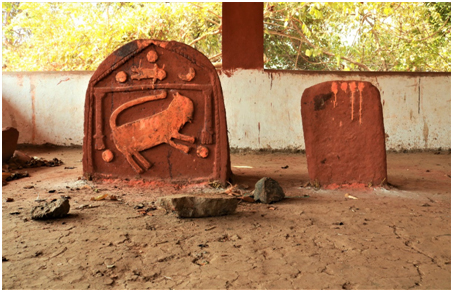Big cats have found cultural representation across their natural ranges. These representations are manifested in the form of art, kinship relations, taboos and even worship. This can be seen with regard to the Were-jaguars that are an intrinsic part of various Mesoamerican cultures as well as the cat deities famously worshiped by Egyptians. Closer to home, the Warlis, an indigenous community in Maharashtra, also worship a big cat deity; Waghoba. The Warli have a long history of sharing space with big cats –presently leopards and historically even tigers – which has resulted in beliefs, traditions and practices embedded within the social institution of Waghoba.
Waghoba has been worshipped by numerous communities for generations. Some shrines dedicated to this deity date back to nearly 350-400 years ago. But why is this of any relevance to conservation? A study recently published in Frontiers of Conservation Science explores the role that this ancient and enduring institution plays in the sharing of space between big cats and Warlis in Maharashtra. This study was conducted by researchers from WCS-India, NINA, Norway, Inland Norway University of Applied Sciences, Norway, and was supported by Wildlife Conservation Trust.
Using an ethnographic approach, researchers collected qualitative data using semi-structured interviews and participant observation. Concurrently, they documented 150 shrines dedicated to Waghoba in the landscape. Interview participants, who comprised predominantly of Warli farmers, shamans, teachers and village heads, were asked questions on the role of Waghoba in the lives of the Warli, the history of Waghoba worship, associated festivals, rituals and traditions, and the ties between Waghoba and human-leopard interactions.
Over the course of six months, the researchers encountered numerous narratives on Waghoba, including a few origin stories on how Waghoba came into being. Several versions of the origin story describe how there was a human baby who would transform into a big cat when his mother was away. Then, he would roam around the village and prey on people’s livestock. Frustrated and angry, the villagers vowed to kill the menacing baby. The mother intervened to mediate a negotiation with the villagers so as to let her child live. She told the villagers to offer Waghoba the food that he likes once a year, and he will leave everyone alone. That is the story of how the big cat took sanctuary in the forest.To honour their word, the people installed a Waghoba shrine in each village. A participant quoted in the paper said “The wagh is known and accepted as the king of the jungle. We pray to him so that he protects us and does not do us any harm”. These narratives indicate how people’s perceptions towards big cats is neither a clear-cut notion of conflict nor of co-existence. Their perceptions are multifaceted and complex with elements of fear, awe and kinship towards the big cat.
The study elucidates that rituals and offerings are a crucial part of Waghoba worship, which materialises during the annual Waghbaras festival. Further, the relationship between the Warli and Waghoba is perceived as reciprocal wherein offerings are made, and, in return, Waghoba protects the people. A central actor in this is the local bhagat or shaman, who acts as a medium through which the people and the deity communicate. The authors propose that, consequently, the bhagat also becomes the mediator of the relationship between people and Waghoba.
There is a strong belief in the landscape that misfortunes, especially those regarding livestock depredation by big cats and disease, occur as retribution by the deity, because the people failed to keep up their end of the bargain. In many ways then, the Warlis might be processing such events as having not only biological and economic connotations, but also spiritual connotations. These connotations could, in turn, define how people in the landscape comprehend and react to incidents of livestock depredation. The authors suggest that it is vital for the dominant stakeholders outside of the Warli community (such as the Forest Department, conservation biologists, and other non-Warli residents who interact with leopards) to be informed about and be sensitive to these cultural representations, because it is not just the biological animal that the Warlis predominantly deal with.
The main aim of the study is to contribute towards diversifying the ways in which we understand and approach human-wildlife interactions in academia. The study does so by shedding light on how local institutions that contribute to co-existence are not devoid of conflict, but have a role in constantly negotiating the conflicts that arise. Furthermore, it illuminates the various complex layers this institution is built on, and the scope for future exploration on these dimensions.
Citation: Nair R, Dhee, Patil O, Surve N, Andheria A, Linnell JDC and Athreya V (2021) Sharing Spaces and Entanglements With Big Cats: The Warli and Their Waghoba in Maharashtra, India. Front. Conserv. Sci. 2:683356. doi: 10.3389/fcosc.2021.683356


 CI is a non-profit, non-commercial portal that aims to facilitate wildlife and nature conservation by providing reliable information and the tools needed to campaign effectively.
CI is a non-profit, non-commercial portal that aims to facilitate wildlife and nature conservation by providing reliable information and the tools needed to campaign effectively.